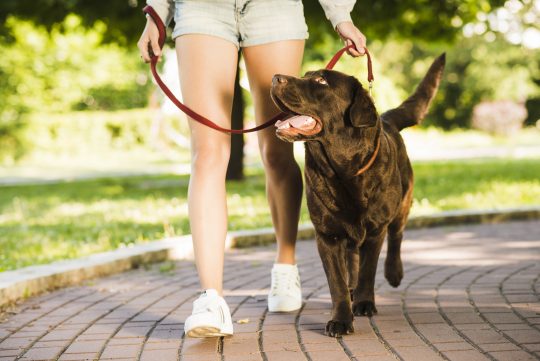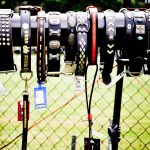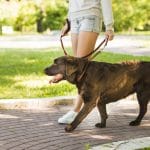Picking Out a Collar & Leash
There are a number of things you’ll need when leash training:
- Appropriate collar or harness depending on breed and size.
- A leash specific once again to your breed and size, as well as to your training style.
They’re one of the most important tools you’ll have. Not to mention, in some places, it’s required by law!
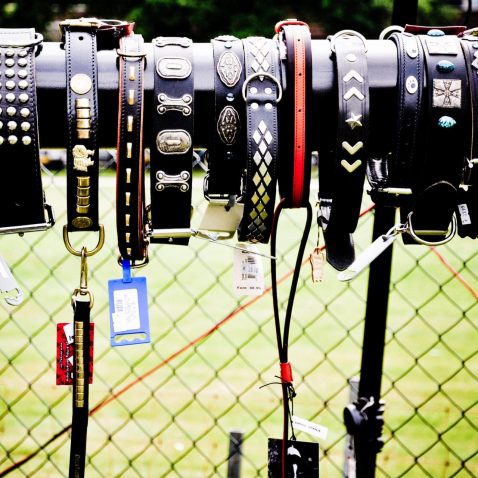
If a collar is too tight, or too loose, your pup can get choked – or escape. This is a situation you don’t want to be in chasing your dog around a field or park screaming their name.
With so many options to pick from, however, which ones should you choose?
Experts recommend a fixed-length, nylon training leash that’s approximately 5 – 6 feet in length, although when preparing for off-leash training a longer leash is generally preferred. It needs to be light enough to not hinder the pup – yet, solid enough not to snap.
However, depending on the breed of your dog, and your height – a longer one may be required.
When it comes to the collar, they suggest an adjustable buckle or snap style nylon collar – or a nylon harness.
A harness can sometimes make a better option if there is any medical issues with the throat. They are also good for dogs who are aggressive pullers as they wont damage the throat. This can also be a con because dogs that pull on harnesses can get lower to the floor and actually pull harder than if they was on a leash similar to sledding, or pulling carts.
To ensure a comfortable fit, make sure you can easily slide 1 – 2 fingers comfortably between the collar (or harness) and the dog’s fur. This way it’s neither too tight nor too loose.
Nylon collars and leashes make great options for growing puppies due to their low-cost and ease of accessibility.
Not only because they outgrow the collars so quickly but, for when they start going through their teething phase as well.
Leash training a puppy that bites the leash can be testing, to say the least.
Many a collar and leash has visited their graveyard through this period of development.
Once you have a collar or harness, and leash, picked out it’s time for the next step.
Familiarizing the Pup with the Collar & Leash
For a lot of pups, their first experience with these essential tools can be scary. As a result, you want to familiarize your puppy with the leash and collar.
So that over time, they become comfortable with them and associate them with something good. You want them to love them, not fear them.

A few things you’ll need on hand to begin are:
- A collar, harness, or both.
- A non-adjustable, sturdy leash.
- And treats – lots and lots of treats.
Once you have all your teaching equipment ready to go – it’s time to start getting the pup acquainted.
A Tired Pup is A Happy Pup
An excellent way to get them ready for you to put on the leash and collar – is to tire them out. Play with them and burn out that energy, this is where a good dog toy will come in handy.
This way they’ll be less likely to react with undesirable responses to you donning them in their new accessories. As a bonus, you’ll be getting extra bonding time in.
Reward Good Behavior
Keep those treats and lots of praises on standby. After your pup allows you to dress him or her up, reward them with affection and goodies.
This will help them start to associate the leash and collar with something good.
Let Them Adjust
Let your pup walk around in the leash and collar while keeping an eye on them.
Just to make sure your pup doesn’t get caught on anything.
Play with them while they are wearing it. Do this gradually increasing time spent with leash on during the day over the course of a week.
Once your pup is used to the collar and leash and it feels natural so to speak, it’s time to..
Let the Training Begin!
When we first take our pup for a walk, they will very likely either be very excited and be chomping at the bit or be very nervous it is important to go slow and ease into it.
Starting with the Basics
When it’s time to commence operation loose-leash training, you’ll need an indoor, distraction-free zone. Where you can introduce the basic commands: “Down,” “Sit,” “Stay,” and “Come” – with and without a leash and collar on.
Keep the sessions short and slowly increase the length over time. You can gradually introduce other distractions to prep them for the next step, too.
When your puppy can demonstrate the ability to follow these basic commands – with and without the leash. As well as, with and without various distractions, they are ready for the next level of real leash training!
Taking it Outdoors
Your pup has shown they can walk on the leash and follow the basic commands.
Now, it’s time to take it up a notch by introducing them to the great outdoors. Also known as a park, or your backyard.
There will be so many new distractions too! New smells, sounds, and sights that will be very enticing to your pup.
They may not be able to resist at first.
When starting outdoor leash training, it will be a new challenge.
Just remember to be patient, and stay consistent with the training – repeating the same steps you took indoors, outdoors. With the exception of removing the leash, of course.
Keeping the walks short, and gradually increasing the time.
Troubleshooting Any Issues That May Arise
While we all like to think our pups are perfect, you can still run into issues during the learning curve. And to get their Canine Good Citizenship award, your puppy will need to be able to show they passed loose-leash training.
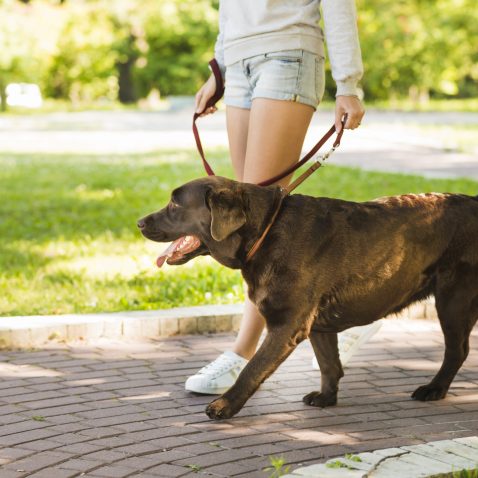
Some basic problems that may arise are:
- Pulling on the Leash
- Lunging After Something
- Barking at Anything and Everything
While their excitement may seem cute, it is not a behavior to encourage – as it puts their safety at risk.
Heel training is essential when leash training, it will teach them to keep their focus 100% on you and to stay by your side.
A few steps to remedy these issues when they arise is to:
- Keep a short leash.
- When stopping at roads be sure to use the heel command to make them stop, then use the sit command.
- When your dog pulls on the leash, give a slight pull on the leash yourself to change the direction of their head away from any distractions, whilst also commanding heel and stopping. This will reinforce that if they are going to pull the walk will stop, it is also good to make them sit as this will calm their behavior.
- Never let your dog walk in front of you, as dogs are pack animals and they will see this as a sign of dominance on their part. They must walk at the side of you, with you leading them in the direction you’re going.
- Remember to pay attention to body language, as dogs express themselves with their bodys.
Tips & Tricks to Keep in Mind
For leash training success, a few things are integral that are very helpful for the process. Especially if you incorporate them into the teachings from the beginning.
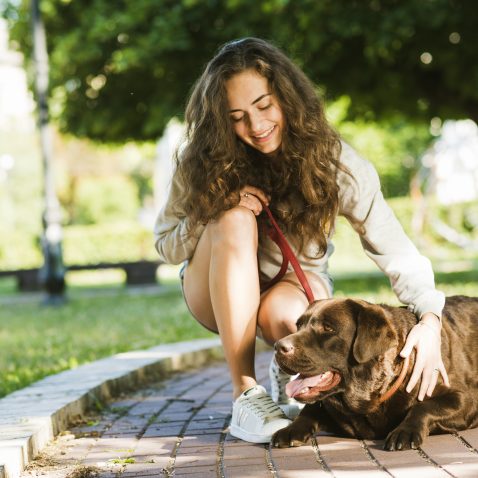
- Be patient, some dog breeds take a lot longer and are more naturally stubborn to this type of training.
- Don’t punish your dog, the best means of training is through positive reinforcement.
- Be mindful of walking your dog in the heat, as hot days are extremely dangerous for dogs.
- Introduce your pup to new things as this encourages good socialization skills and reduces the likeliness of human and dog aggression, it also gets them use to loud noises such as cars which are at first scary to young pups.
- A spare leash is a good idea because some dogs who pull a lot can snap their collars/leashes.
- Always bring doggy bags and a water bottle, it is illegal to not clean up your dog’s messes. Some dog have sensitive stomachs and its not always easy to clean up their poop which is why it’s handy to bring a water bottle.
- Dogs who are confined to small spaces like dog crates or kennels will need more exercise than dogs who are free to roam.
Summary
Going the DIY approach when training your pup is an excellent way to bond, and spend time with your new family member. Even though given, it can be a little taxing at times, but it’s completely worth it in the end.
Leash training is a great way to incorporate and solidify teachings from other types of training, too! Like potty training, house training, and basic commands.
Just remember to be consistent, patient, and to be good company.
We hope you enjoyed this article, and that it assisted you on your leash training journey! Let us know how these tips went for you – or if you have any questions.
We love to help, and we especially love to hear success stories!
Furthermore, if you liked this guide you may also like our product review for best dog shampoo for odor, for the times your puppy comes home smelling worse for wear after a walk.
Share the Love
If you found this post useful, please let others know about it by sharing it.
